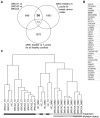Use of DNA-damaging agents and RNA pooling to assess expression profiles associated with BRCA1 and BRCA2 mutation status in familial breast cancer patients
- PMID: 20174566
- PMCID: PMC2824809
- DOI: 10.1371/journal.pgen.1000850
Use of DNA-damaging agents and RNA pooling to assess expression profiles associated with BRCA1 and BRCA2 mutation status in familial breast cancer patients
Abstract
A large number of rare sequence variants of unknown clinical significance have been identified in the breast cancer susceptibility genes, BRCA1 and BRCA2. Laboratory-based methods that can distinguish between carriers of pathogenic mutations and non-carriers are likely to have utility for the classification of these sequence variants. To identify predictors of pathogenic mutation status in familial breast cancer patients, we explored the use of gene expression arrays to assess the effect of two DNA-damaging agents (irradiation and mitomycin C) on cellular response in relation to BRCA1 and BRCA2 mutation status. A range of regimes was used to treat 27 lymphoblastoid cell-lines (LCLs) derived from affected women in high-risk breast cancer families (nine BRCA1, nine BRCA2, and nine non-BRCA1/2 or BRCAX individuals) and nine LCLs from healthy individuals. Using an RNA-pooling strategy, we found that treating LCLs with 1.2 microM mitomycin C and measuring the gene expression profiles 1 hour post-treatment had the greatest potential to discriminate BRCA1, BRCA2, and BRCAX mutation status. A classifier was built using the expression profile of nine QRT-PCR validated genes that were associated with BRCA1, BRCA2, and BRCAX status in RNA pools. These nine genes could distinguish BRCA1 from BRCA2 carriers with 83% accuracy in individual samples, but three-way analysis for BRCA1, BRCA2, and BRCAX had a maximum of 59% prediction accuracy. Our results suggest that, compared to BRCA1 and BRCA2 mutation carriers, non-BRCA1/2 (BRCAX) individuals are genetically heterogeneous. This study also demonstrates the effectiveness of RNA pools to compare the expression profiles of cell-lines from BRCA1, BRCA2, and BRCAX cases after treatment with irradiation and mitomycin C as a method to prioritize treatment regimes for detailed downstream expression analysis.
Conflict of interest statement
The authors have declared that no competing interests exist.
Figures



Similar articles
-
BRCA1 and BRCA2 missense variants of high and low clinical significance influence lymphoblastoid cell line post-irradiation gene expression.PLoS Genet. 2008 May 23;4(5):e1000080. doi: 10.1371/journal.pgen.1000080. PLoS Genet. 2008. PMID: 18497862 Free PMC article.
-
Classifications within molecular subtypes enables identification of BRCA1/BRCA2 mutation carriers by RNA tumor profiling.PLoS One. 2013 May 21;8(5):e64268. doi: 10.1371/journal.pone.0064268. Print 2013. PLoS One. 2013. PMID: 23704984 Free PMC article.
-
Cyclin D1 expression analysis in familial breast cancers may discriminate BRCAX from BRCA2-linked cases.Mod Pathol. 2008 Oct;21(10):1262-70. doi: 10.1038/modpathol.2008.43. Epub 2008 Mar 7. Mod Pathol. 2008. PMID: 18327210
-
Twenty Years of BRCA1 and BRCA2 Molecular Analysis at MMCI - Current Developments for the Classification of Variants.Klin Onkol. 2019 Summer;32(Supplementum2):51-71. doi: 10.14735/amko2019S51. Klin Onkol. 2019. PMID: 31409081 Review. English.
-
Chromosomal mutagen sensitivity associated with mutations in BRCA genes.Cytogenet Genome Res. 2004;104(1-4):325-32. doi: 10.1159/000077511. Cytogenet Genome Res. 2004. PMID: 15162060 Review.
Cited by
-
The rs11515 Polymorphism Is More Frequent and Associated With Aggressive Breast Tumors with Increased ANRIL and Decreased p16 (INK4a) Expression.Front Oncol. 2016 Jan 21;5:306. doi: 10.3389/fonc.2015.00306. eCollection 2015. Front Oncol. 2016. PMID: 26835415 Free PMC article.
-
A guide for functional analysis of BRCA1 variants of uncertain significance.Hum Mutat. 2012 Nov;33(11):1526-37. doi: 10.1002/humu.22150. Epub 2012 Jul 16. Hum Mutat. 2012. PMID: 22753008 Free PMC article. Review.
-
Genome-Wide Gene Expression Analyses of BRCA1- and BRCA2-Associated Breast and Ovarian Tumours.Cancers (Basel). 2020 Oct 16;12(10):3015. doi: 10.3390/cancers12103015. Cancers (Basel). 2020. PMID: 33081408 Free PMC article. Review.
-
Safety and efficacy of combination of suberoylamilide hydroxyamic acid and mitomycin C in reducing pro-fibrotic changes in human corneal epithelial cells.Sci Rep. 2021 Feb 23;11(1):4392. doi: 10.1038/s41598-021-83881-y. Sci Rep. 2021. PMID: 33623133 Free PMC article.
-
Increased gene expression variability in BRCA1-associated and basal-like breast tumours.Breast Cancer Res Treat. 2021 Sep;189(2):363-375. doi: 10.1007/s10549-021-06328-y. Epub 2021 Jul 21. Breast Cancer Res Treat. 2021. PMID: 34287743 Free PMC article.
References
-
- Perou CM, Sorlie T, Eisen MB, van de Rijn M, Jeffrey SS, et al. Molecular portraits of human breast tumours. Nature. 2000;406:747–752. - PubMed
-
- Weigelt B, Hu Z, He X, Livasy C, Carey LA, et al. Molecular portraits and 70-gene prognosis signature are preserved throughout the metastatic process of breast cancer. Cancer Res. 2005;65:9155–9158. - PubMed
-
- Finak G, Bertos N, Pepin F, Sadekova S, Souleimanova M, et al. Stromal gene expression predicts clinical outcome in breast cancer. Nat Med. 2008;14:518–527. - PubMed
Publication types
MeSH terms
Substances
LinkOut - more resources
Full Text Sources
Other Literature Sources
Medical
Molecular Biology Databases
Miscellaneous

